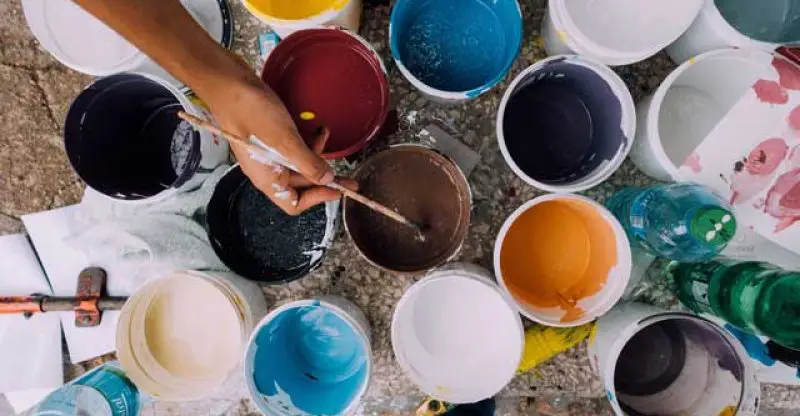What Happens If You Use Old Paint?
If you have painted your house, you probably have some leftover old paint. However, paint is classified as hazardous waste and must not be disposed of in regular trash. So, it’s essential to know what to do with old paint.
Once opened, paint has a shorter lifespan compared to unopened cans. If stored in a cool, dry place, an opened can of paint will last for around 2 years.
However, after 2 years, it’s best to test the paint to determine if it’s still good to use. Although it’s possible to use paint that’s more than two years old, it’s not advisable.
Most people have unused paint at home. It’s always best to use the same color as the wall or decoration to make sure everything looks cohesive.
In this article, we’ll discuss why paints go bad, what happens if you use old paint, how to determine if it’s still usable, and how to safely dispose of paint.
What Happens to Paint Over Time?
As paint ages, it undergoes various changes that can affect its overall quality and performance. One of the most significant changes that occur is the chemical breakdown of the paint, which can cause it to lose its original properties.
This can result in the paint becoming less viscous and less capable of forming a stable film on the surface it is applied. The breakdown of the binder and other additives can lead to changes in texture, color, and finish.
Another issue that can arise with old paint is the evaporation of solvents. Solvents are used in paint to help with application and evaporation.
As the paint ages, these solvents can evaporate, leading to changes in the viscosity and consistency of the paint. This can result in the paint becoming thicker and more difficult to apply.
Over time, the pigments in the paint can also change or fade, which can alter the color and hue of the paint. This can result in uneven color distribution and a less vibrant finish.
Finally, exposure to air and sunlight can also have detrimental effects on old paint, causing it to dry out, form clumps, and develop skin on the surface.
All of these changes can contribute to poor performance and reduced durability, making old paint a less-than-ideal choice for any painting project.
What Happens If You Use Old Paint?
Old paint would just not perform well. The coating will leave a harsh finish, and the paint will most likely fracture and chip.
The vapors from old paint are extremely irritating to your eyes, throat, and nose. Once you are exposed to the vapors for an extended period of time you may become ill.
Negative impacts could include mold on your walls (bad), glopping in your rollers that tend to end up on the surface of your walls (unappealing), inappropriate drying via running or streaking, and low coverage quality. Brightness could also be damaged.
Due to the paint splitting and drying, expired paints can tend to cluster together, therefore utilizing outdated paints (Acrylics, for instance) can make a painting look untidy or clumsy, especially if you’re applying numerous applications. I strongly encourage you to avoid it.
How Long Does Paint Last?
Before we dive into the details of what happens if you use old paint, let’s first understand how long paint lasts. The shelf life of paint depends on several factors, such as the type of paint, storage conditions, and whether the can has been opened or not.
Water-based latex paints typically last up to 10 years if stored properly in a cool, dry place. On the other hand, oil-based paints have a shorter shelf life and can last up to 7-10 years. However, if the paint has been exposed to extreme temperatures, humidity, or direct sunlight, it can deteriorate much faster.
What Happens When Paint Ages?
When paint ages, several issues arise. First and foremost, the paint’s color may change, making it challenging to achieve the desired aesthetics. Furthermore, the consistency of old paint may become thick and clumpy, making it challenging to apply smoothly.
Effects on Aesthetics
Using old paint can lead to inconsistent color and finish on your surfaces, which can be frustrating and unattractive. This inconsistency may require additional coats, which increases the cost and effort involved in your painting project.
Impact on Durability
Old paint may not adhere well to surfaces, leading to premature peeling and chipping. This can compromise the durability and longevity of your paint job, resulting in the need for more frequent maintenance and repainting.
Health Concerns
Old paint can also pose health risks. The chemicals in aging paint can break down, releasing harmful fumes or allergens. This can be particularly problematic if you’re repainting indoor areas, as it can affect air quality and your well-being.
Environmental Implications
Using old paint can have a negative impact on the environment. Improper disposal of old paint can lead to soil and water contamination. This can harm local ecosystems and wildlife. Therefore, it’s essential to consider the environmental implications of using old paint.
Risks of Using Old Paint?
- Poor Adhesion: Old paint may not adhere properly to the surface, resulting in a patchy or uneven finish that is prone to peeling.
- Uneven Color Distribution: The pigments in old paint may have settled or separated, causing the color to be uneven and streaky.
- Reduced Coverage: Old paint may not cover as well as fresh paint, requiring multiple coats to achieve the desired coverage.
- Increased Risk of Peeling and Cracking: Old paint may become brittle over time, increasing the risk of peeling and cracking, especially in areas with high moisture or temperature changes.
- Potential Health Risks: Old paint may contain harmful chemicals that can be released during use, putting you at risk of respiratory problems, skin irritation, or other health issues.
- Bacterial growth: Old paint may contain bacteria, which can cause mold and mildew growth on the wall.
- Foul odor: Old paint may develop a rancid or rotten-egg odor, making it unpleasant to work with.
Alternatives to Using Old Paint
In this section, we will explore three options for dealing with old paint. Each of these options has unique benefits and considerations to keep in mind.
Donating Old Paint
Donating old paint is a great way to ensure that it doesn’t go to waste. Many organizations accept donations of unused paint, including Habitat for Humanity and local community centers.
Some organizations have specific requirements for the type of paint they accept, such as only accepting latex-based paint, so be sure to check their guidelines before donating.
Recycling Options
Some paint manufacturers offer recycling programs for old paint. These programs typically involve the paint being turned into a new product, such as a new paint color or a non-paint product. In addition, some recycling centers accept paint for proper disposal.
Proper Disposal Methods
If you cannot donate or recycle your old paint, it is important to dispose of it properly. Improper disposal of paint can be harmful to the environment and pose health risks.
The best way to dispose of old paint is to take it to a hazardous waste disposal facility or contact your local government for proper disposal instructions.
In general, it is important to never pour paint down the drain or throw it in the trash, as this can contaminate water sources and harm wildlife.
How to Make Old Paint Usable Again?
If you have old paint that you want to use again, these steps can help you make it usable:
- Inspect the paint for clumps, separation, or unpleasant odor.
- Stir the paint thoroughly. If required, you can add a paint conditioner or thinner to it.
- Test the paint’s consistency on a scrap surface.
- If the paint is too thick, thin it with a maximum of 10% water.
- To remove impurities, filter the paint.
- Seal the can tightly and store it in a cool, dry place.
- Properly label the can. Your old paint is now ready for use in future projects.
Conclusion
The life span of paint is substantially shortened after the can is opened. Air exposure, extreme heat, and spontaneous dispersion of the paint can all make it useless.
It’s important to properly store and dispose of old paint and to always use fresh paint for your painting projects. By doing so, you can ensure a beautiful, long-lasting finish while also protecting yourself and the environment.
I hope this information comes in helpful when you clean out your garage or sheds this year. And if you have any similar tips to share, please do so; I’d love to hear them.
FAQs
After being opened, paint is generally good for 2-4 years if stored properly with the lid tightly closed and stored in a cool, dry place.
Expired paint may still be usable if it has been stored properly and does not show signs of damage or separation, but it’s generally recommended to use fresh paint for the best results.
While it may be tempting to use old paint. It’s generally not recommended due to risks such as poor adhesion, uneven color, reduced coverage, increased risk of peeling and cracking, and potential health risks.



